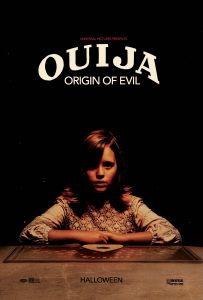
I have not seen “Ouija” and, by all accounts, I don’t need to. Critics gave it a thrashing, horror aficionados rejected it, and the few friends I know who’ve seen it didn’t care for it either. Even in seeing its sequel, I didn’t need to watch the first to keep up. “Origin of Evil” is a prequel that, to my knowledge, has no connection to the 2014 film aside from the titular board game. I’d be curious to find out if there is a connection, but my better judgment dissuades me from biting the bullet (though the Cinemasochist within me is chomping at the bit).
While I may not be able to speak on behalf of “Ouija,” I can vouch for the quality of “Origin of Evil.” Said quality is surprisingly good! This may be a cookie cutter horror tale on the surface, but Mike Flanagan, along with co-writer Jeff Howard, spice things up with energy and care. I wouldn’t be surprised to learn this was a director-for-hire situation, with Flanagan taking the payday to fund more ambitious projects (such as “Hush”). If this is the case, I commend him for not phoning it, but making chicken salad out of chicken shit.
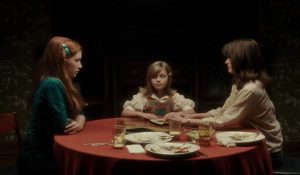
“Origin of Evil” sounds too cheesy to work. It’s based off of a board game, one reliant on the participation and spiritual belief of the player. While the prop lends itself well to a horror story, what with the board being able to talk to the dead, trying to write a story around its origin sounds laughable. And yet, here I am, praising said origin. What a crazy world we live in!
Flanagan wisely makes the film about the family haunted by the Ouija board and not the board itself. The game takes a backseat to the drama and demonic activity, acting more like a McGuffin. It acts as the gateway to Hell for the Zander family, who perform phony séances out of their home. The game is meant to be nothing more than a prop, but it lives up to its moniker in communicating with the dead. I won’t reveal the twist as to how it actually works, but it’s quite clever in a corny way. Make no bones about it, the film is corny. Flanagan realizes this and coyly plays with the conventions. There’s even a snarky criticism on the splitting up theory from one of the characters, taking the piss out of that asinine strategy. It’s written in a way that’s natural, as opposed to snidely breaking the fourth wall (I’m looking at you, Kevin Williamson).
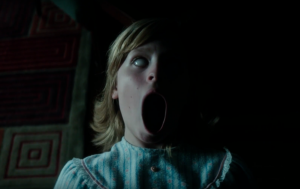
What isn’t corny is the relationship between the Zander family. They’ve been coping with the loss of the father for some time now, a victim of a drunk driver. The mother, Alice (Elizabeth Reaser), has resorted to performing séances to pay the bills, a tradition in her family. Secretly, she does it to cope with her loss, as giving customers closure brings her comfort. Her daughters don’t quite see it that way. The oldest, Lina (Annalise Basso), is growing resentful of the scam, while the youngest, Doris (Lulu Wilson), is too naïve to grasp the severity of it. There’s the usual familial conflict, such as teen rebellion and concern from the school, but it’s made palatable by the endearing performances. Horror films of this variety tend to view their characters as nothing more than haunted house patrons, existing solely to give leverage to the events, so it’s refreshing to see a director view them as human.
Also refreshing is the slow build. While it doesn’t take long for the demons to connect with our world, they don’t rush to the finish line. They take hold of Doris, pretending to be her friend with access of communication to her father. They gain her trust, then take possession of her soul. They do this gradually, first manipulating her confidence in order to conform the family. Her newfound power is discovered and exploited by her mother, but not in callous fashion. She uses it to communicate with her late husband and genuinely bring comfort to other tormented souls. Just as she grows comfortable with the presence, it takes hold of her daughter in violent fashion.
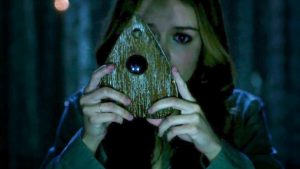
If one is to believe paranormal investigators, then they’d know that demons are believed to gain confidence in their host before striking. This way, it’s easier for them to attack once their victim’s guard is down. True or not, it makes for good tension, relying more on compassion than jump scares. This is where Flanagan’s focus lies, only sprinkling in the occasional jump scare to appease the casual audience (and possibly the studio). By making us warm to the family, it allows the viewer to overlook the familiar tropes. I grew comfortable with the familiarity as most of it was implemented into the story efficiently. Only the voice modification on Doris during séances and the occasional imagery (such as the demon entering Doris’ body) were too cheesy to overcome. Creepy imagery, such as the blank eyes that denote the demon’s presence and the contents of the dungeon hidden inside the basement walls, more than makes up for the cheesiness.
Praise must also be given to the exemplary set design that properly converts the film into 1965 Los Angeles. Period pieces tend to overplay their hand, drowning the settings in that decade’s fashion. Here, the 60s aesthetic is reserved and underplayed. Culottes and go-go boots may dominate the screen, but attention isn’t drawn to them. Political commentary meant to age the film is kept to a minimum, with discussions on space exploration and changing social trends reserved to casual conversations and television static. The vibrant colors of Fall and Catholic school conformity go a long way in building atmosphere and timestamping the film. Subtle nuances in the film print, such as minor grains and black spots, make it look damaged like B-movies passed around from theater to theater in the 60s. It’s not enough to distract the production, as it was intentionally done so in “Grindhouse,” but aids in making the film feel like a products of its decade. Regardless, it’s a crisp-looking film!
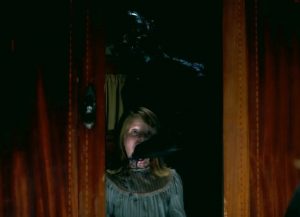
“Origin of Evil” is the perfect candidate for Halloween viewing! It builds dread well through old-school techniques. It’s filled with enough haunting imagery to satiate the demands for spooky content. It adheres to conventions as to play to a wide audience, sometimes to a fault. Characters such as Father Tom (Henry Thomas) and Lina’s boyfriend, Mikey (Parker Mack), feel like fodder more than anything, despite their best intentions. The script tends to over-explain the backstory, slightly diminishing the impact. Even these lesser qualities are presented with finesse to carry them to the thrilling, albeit too long, finale.
This was a pleasant treat!
Final Rating: B
